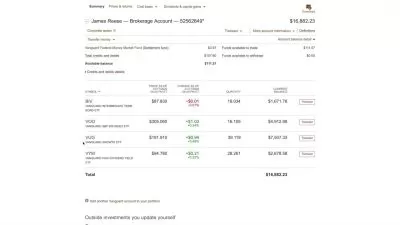IPO Masterclass - IPOs | FPOs | Valuation | Raising Capital
EDUCBA Bridging the Gap
6:27:28
Description
IPO| FPO| role of investment banks| IPO modeling & Valuation| Primary Markets| Process of an IPO| Book Building
What You'll Learn?
- Through these tutorials we are going to see how the IPO process take place in an investment bank.
- This training would be covering up various IPO analysis w.r.t companies
- In-depth analysis of how a company goes public, major mistakes to be avoided while going in, as well as valuation concepts would be covered.
- Learn about Primary Markets, Advantages‚ Disadvantages, Process of an IPO, Book Building, IPO Grading, Greenshoe Option, Short Selling
- Difference between an IPO and an FPO
- IPO valuation/modeling
- Role of an investment bank in capital raising
Who is this for?
What You Need to Know?
More details
DescriptionYou would have heard much about the IPO Definition if you were a finance guy. Business newspapers keep featuring why a particular IPO process is hot, whether it will succeed, how much the company would raise, and many other things. For those new to this term, an IPO Definition or the IPO Meaning is "Initial Public Offering," where a private firm decides to transform itself into a public one. The company will offer its stock for trading on the stock exchange for the first time, inviting the public to invest in it.
When any private organization wants to grow but lacks capital required for it, instead of taking debt from banks, it decides to go public and sell shares. It goes to Investment Bank to set up IPO. IB arranges for IPO where shares are divided as per the capital requirement and in this way public buys those shares and business gets money.
Through this training we shall learn about fund raising options IPO, FPO, the role of investment banking in the same and IPO modeling.
Raising capital
Role of an investment bank in capital raising
IPOs and FPOs:
Difference between an IPO and an FPO
IPO valuation/modelling
Summary and recapitulation
Initial Public Offering (IPO) is the process by which a privately-held company issues new shares of stock to the public for the first time. It allows the company to raise capital by selling shares of ownership to the public, and it also allows the public to buy shares in the company. Going public can be complex and time-consuming and typically involves using investment bankers to underwrite the offering and help the company price the shares. Once the IPO is complete, the stock exchange lists the shares, and they become available for public trading.
Advantages of IPO
Raising Capital: An Initial Public Offering (IPO) is a way for a company to raise additional capital for its business operations. By selling shares of their company to the public, a company can raise a large sum of money quickly.
Increase in Business Credibility: A company that goes public must comply with many regulations, such as the Sarbanes-Oxley Act. It helps increase the company's credibility with investors, leading to more investments.
Increased Liquidity: An IPO increases the liquidity of a company's shares, making it easier for shareholders to buy and sell company shares.
Access to Debt Financing: Companies that go public have access to more debt financing than private companies. It can benefit companies that need to finance large projects or acquisitions.
Improved Brand Image: Going public can help to improve the company's brand image and increase its visibility in the marketplace.
Capital raising: An IPO is an effective way to raise capital for the company. This capital can fund new projects, expand operations, finance acquisitions, or pay off debt.
Increased visibility: When a company goes public, it gains increased visibility and credibility. It can attract more customers, suppliers, and partners.
Improved corporate governance: A company must adhere to stricter financial reporting and disclosure standards by going public. It can help to improve the company's corporate governance and increase investor confidence.
Who this course is for:
- Financial analysts, Investment Banking associates, Anyone who wants to learn about the basics of an IPO.
You would have heard much about the IPO Definition if you were a finance guy. Business newspapers keep featuring why a particular IPO process is hot, whether it will succeed, how much the company would raise, and many other things. For those new to this term, an IPO Definition or the IPO Meaning is "Initial Public Offering," where a private firm decides to transform itself into a public one. The company will offer its stock for trading on the stock exchange for the first time, inviting the public to invest in it.
When any private organization wants to grow but lacks capital required for it, instead of taking debt from banks, it decides to go public and sell shares. It goes to Investment Bank to set up IPO. IB arranges for IPO where shares are divided as per the capital requirement and in this way public buys those shares and business gets money.
Through this training we shall learn about fund raising options IPO, FPO, the role of investment banking in the same and IPO modeling.
Raising capital
Role of an investment bank in capital raising
IPOs and FPOs:
Difference between an IPO and an FPO
IPO valuation/modelling
Summary and recapitulation
Initial Public Offering (IPO) is the process by which a privately-held company issues new shares of stock to the public for the first time. It allows the company to raise capital by selling shares of ownership to the public, and it also allows the public to buy shares in the company. Going public can be complex and time-consuming and typically involves using investment bankers to underwrite the offering and help the company price the shares. Once the IPO is complete, the stock exchange lists the shares, and they become available for public trading.
Advantages of IPO
Raising Capital: An Initial Public Offering (IPO) is a way for a company to raise additional capital for its business operations. By selling shares of their company to the public, a company can raise a large sum of money quickly.
Increase in Business Credibility: A company that goes public must comply with many regulations, such as the Sarbanes-Oxley Act. It helps increase the company's credibility with investors, leading to more investments.
Increased Liquidity: An IPO increases the liquidity of a company's shares, making it easier for shareholders to buy and sell company shares.
Access to Debt Financing: Companies that go public have access to more debt financing than private companies. It can benefit companies that need to finance large projects or acquisitions.
Improved Brand Image: Going public can help to improve the company's brand image and increase its visibility in the marketplace.
Capital raising: An IPO is an effective way to raise capital for the company. This capital can fund new projects, expand operations, finance acquisitions, or pay off debt.
Increased visibility: When a company goes public, it gains increased visibility and credibility. It can attract more customers, suppliers, and partners.
Improved corporate governance: A company must adhere to stricter financial reporting and disclosure standards by going public. It can help to improve the company's corporate governance and increase investor confidence.
Who this course is for:
- Financial analysts, Investment Banking associates, Anyone who wants to learn about the basics of an IPO.
User Reviews
Rating
EDUCBA Bridging the Gap
Instructor's Courses
Udemy
View courses Udemy- language english
- Training sessions 45
- duration 6:27:28
- Release Date 2024/04/13


















